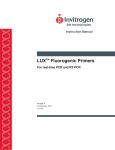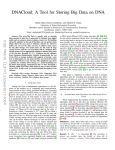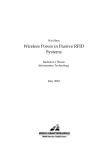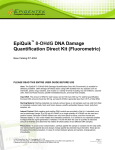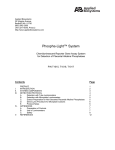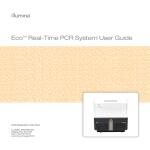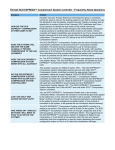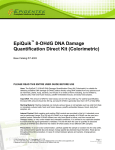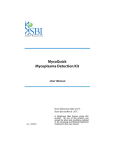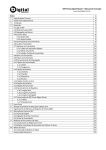Download Real-Time PCR - Gene-Quantification.info
Transcript
Instruction Manual LUX™ Fluorogenic Primers For real-time PCR and RT-PCR Version B 091802 25-0546 ii Table of Contents Introduction ......................................................................................................................1 Designing and Ordering Primers......................................................................................3 Storing and Reconstituting Primers..................................................................................5 Real-Time PCR................................................................................................................6 Multiplex Real-Time PCR.................................................................................................8 Two-Step Real-Time RT-PCR..........................................................................................9 One-Step Real-Time RT-PCR .......................................................................................11 Troubleshooting .............................................................................................................14 Accessory Products .......................................................................................................15 Purchaser Notification....................................................................................................16 Technical Service...........................................................................................................17 References ....................................................................................................................19 iii iv Introduction Overview LUX™ (Light Upon Extension) primers are an easy to use, highly sensitive, and efficient method for performing real-time (“quantitative”) PCR and RT-PCR. LUX™ primers combine high specificity and multiplexing capability with simple design and streamlined protocols. LUX™ primers are compatible with melting curve analysis of real-time PCR products, allowing the differentiation of amplicons and primer dimer artifacts by their melting temperatures. LUX™ primers require no special probes or quenchers, and can be ordered direct from Invitrogen. Each primer pair in the LUX™ system includes a fluorogenic primer with a fluorophore attached to its 3′ end, as well as a corresponding unlabeled primer. The fluorogenic primer has a short sequence tail of 4–6 nucleotides on the 5′ end that is complementary to the 3′ end of the primer. The resulting hairpin secondary structure provides optimal quenching of the fluorophore (see the figure below). When the primer is incorporated into the doublestranded PCR product, the fluorophore is dequenched and the signal increases by up to 10-fold. LUX™ Primer Reaction Relative fluorescence: 0.1 Hairpin primer 0.4 Single-stranded primer 1.0 Extended primer (double-stranded DNA) Labeling Each fluorogenic LUX™ primer is labeled with one of two reporter dyes—FAM (6-carboxy-fluorescein) or JOE (6-carboxy-4', 5'-dichloro-2', 7'-dimethoxyfluorescein). Additional reporter dyes will be available in the future. A multiplex real-time reaction contains different primer sets, each with a different label, to detect different genes in the same sample. Continued on next page 1 Introduction, Continued Applications LUX™ primers can be used in real-time PCR and RT-PCR to quantify 100 or fewer copies of a target gene in as little as 1 pg of template DNA or RNA. LUX™ primers have a broad dynamic range of 7–8 orders. Multiplex applications use separate FAM and JOE-labeled primer sets to detect two different genes in the same sample. Typically, the FAM-labeled primer is used to detect the gene of interest and the JOE-labeled primer is used to detect a housekeeping gene used as an internal control. Instrument Compatibility LUX™ primers are compatible with a wide variety of real-time PCR instruments, including but not limited to the ABI PRISM® 7700/7000/7900 and GeneAmp® 5700, the Bio-Rad iCycler™, the Stratagene Mx4000™, and the Cepheid Smart Cycler®. ABI PRISM is a registered trademark of Applera Corporation. GeneAmp is a registeredtrademark of Roche Molecular Systems, Inc. iCycler, Mx4000, and Smart Cycler are trademarks of their respective companies. 2 Designing and Ordering Primers LUX™ Designer Web-based Design Software To design and order LUX™ primers, visit the Invitrogen LUX™ Web site at www.invitrogen.com/LUX and follow the link to the LUX™ Designer Webbased design software. Follow the step-by-step instructions in the software to submit target sequences containing your genes of interest and generate primer designs. At any point in the process, click on the LUX™ Designer Help button for more detailed instructions and assistance. LUX™ Designer will automatically generate one or more primer designs based on each sequence you submit and the selected design parameters. The design software includes algorithms to minimize primer self-complementarity and interactions between primers. It also assigns rankings to the generated designs—based on primer melting temperature, hairpin structure, selfannealing properties, etc.—to aid in selection. When the designs have been generated, you can review them, select a design, select the fluorophore labels, and place your order. Submitting a Target Sequence Selecting a Primer Design When you submit a target sequence containing your gene of interest, keep in mind the following design criteria: • The optimal amplicon length for real-time PCR ranges from 80 to 200 bases. You can specify a minimum, optimal, and maximum amplicon length when you submit the sequence. • The target sequence should be at least 10 bases longer than the minimum amplicon size you select. The longer the sequence, the more likely that an optimal primer design can be developed. • The sequence must contain only standard IUPAC (International Union of Pure and Applied Chemistry) letter abbreviations. • When you first submit a sequence, the Disable Penalty Checking checkbox should not be checked; the resulting penalty scores provide an important measure of primer suitability. Penalty scores in the range of 0.0–4.0 are acceptable. If no primers with a penalty score of 4.0 or lower are generated, you may choose to disable Penalty Checking and redesign the primers. Note that if you select a primer with a higher penalty score, the efficiency of the reaction may be less than optimal. See the LUX™ Designer Help for guidance in optimizing your design parameters and/or sequence. • When you select the design parameters, the default melting temperature range is 60–68oC. Do not change this default unless the design engine finds no primers in this range. For primers in this range, PCR programs with annealing temperatures from 55o to 64oC are appropriate. After you submit your sequence, LUX™ Designer will first generate one or more designs for the labeled primer. The labeled primer can be either the forward or the reverse primer (note the recommendation for one-step RT-PCR on the following page). After you select a design for the labeled primer, you will be prompted to select a design for the corresponding unlabeled primer. Continued on next page 3 MEND ION AT RECOM Designing and Ordering Primers, Continued In one-step RT-PCR (see the sample reaction on page 11), the reverse primer drives the reverse transcription reaction. We have found that labeling the reverse primer with the LUX™ fluorophore can inhibit this RT step; therefore, we strongly recommend that you select the forward primer as the labeled primer. You should choose a forward primer as the labeled primer for onestep RT-PCR regardless of its penalty score. If no forward primer can be generated for the sequence, you may select the reverse primer as the labeled primer, noting that the efficiency of the reaction may be compromised. Selecting Labels After you have selected a primer set (labeled and unlabeled) for a particular sequence, you can specify the particular label and synthesis scale When selecting labels in a multiplex reaction, we recommend using the FAM label for your gene of interest and the JOE label for the housekeeping gene that you will use as the internal control. Placing the Order After you have selected the label and synthesis scale, you can submit your order directly from the LUX™ Designer Web site. Each primer order will be shipped directly from Invitrogen’s Custom Primer Facilities. Labeled and unlabeled primers are shipped separately. Labeled primers are shipped in an amber tube; unlabeled primers are shipped in a clear tube. Each primer ordered from Invitrogen’s Custom Primer Facilities comes with a Certificate of Analysis (COA) verifying the amount and sequence. Product Qualification LUX™ primers are provided in 50 nM or 200 nM synthesis scale. They are tested post-synthesis by optical density (OD) ratio measurements and mass spectroscopy to ensure efficient dye labeling and correct molecular weight and composition. See the Certificate of Analysis shipped with each primer for more information. 4 Storing and Reconstituting Primers Primer Storage and Stability Store primers at –20oC in the dark. Primers are stable for: • >12 months when stored at –20oC in lyophilized form. • >6 months when stored at –20oC in solution. Stability can be extended by storing at –70oC. Reconstituting Primers LUX™ primers are provided in 50 nmole or 200 nmole synthesis scale. To reconstitute primers, centrifuge the tube for a few seconds to collect the oligonucleotide in the bottom of the tube. Carefully open, add an appropriate volume of TE buffer or ultrapure water, close the tube, rehydrate for 5 minutes, and vortex for 15 seconds. We recommend that you rehydrate primers at concentrations greater than 10 µM. To prepare a 100 µM primer stock solution, multiply the primer amount in nmoles by ten to determine the volume of diluent in µl. After reconstitution, store the primer stock at –20oC in the dark, where it will be stable for 6 months or more. 5 Real-Time PCR Introduction This section provides guidelines and an optimized protocol for performing real-time PCR using LUX™ primers. Template Specifications The target template for real-time PCR is linear single-stranded or doublestranded DNA, cDNA, or circular DNA (such as plasmids). The amount of DNA typically ranges from 102 to 107 copies or 1 pg to 10 µg of template. See page 9 for instructions on generating cDNA using reverse transcription as part of two-step real-time RT-PCR. Primer Concentration For optimal PCR conditions, primer titrations of 50–500 nM per primer are recommended. The 50 µl sample reaction on the following page uses 200 nM of each primer, equivalent to 1 µl of a 10 µM primer solution. Magnesium Concentration The optimal Mg++ concentration for a given target/primer/polymerase combination can vary between 1 mM and 10 mM, but is usually in the range of 3 mM. See the sample reaction on page 7. dNTP Concentration The optimal concentration of dATP, dCTP, dGTP, and dTTP is 200 µM each. If dUTP is used in place of dTTP, its optimal concentration is 400 µM. Instrument Specifications LUX™ primers are compatible with a wide variety of real-time PCR instruments with various detection capabilities, including but not limited to the ABI PRISM® 7700/7000/7900 and GeneAmp™ 5700, the Bio-Rad iCycler™, the Stratagene Mx4000™, and the Cepheid Smart Cycler®. At a minimum, the instrument used to perform real-time PCR with LUX™ primers must be able to: • Detect fluorescence at each PCR cycle • Excite FAM- and JOE-labeled LUX™ primers near their excitation wavelength maximums of 490 nm and 520 nm, respectively • Detect the emission of FAM and JOE-labeled LUX™ primers near their emission maximums of 520 nm and 550 nm, respectively Please refer to the specific instrument’s user manual for operating instructions. Instrument Settings Please follow the manufacturer’s instructions for configuring your real-time PCR instrument for use with LUX™ primers. Note the following settings: • Because LUX™ primers do not contain a quencher, the quencher setting should be set to no quencher. • We recommend the use of ROX reference dye (Catalog no. 12223-023) for normalization of well-to-well variation. Adjust your instrument reference setting accordingly. Continued on next page 6 Real-Time PCR, Continued Enzyme Specifications We recommend using a “hot-start” DNA polymerase, preferably one that has been optimized for real-time PCR. Platinum® Quantitative PCR SuperMixUDG, available from Invitrogen (Catalog no. 11730-017), is a 2X-concentrated, ready-to-use reaction mixture containing all components except primers and template. It uses Platinum® Taq DNA polymerase, and has been specifically formulated to provide optimal performance in real-time PCR systems. See the sample protocol below. Real-Time PCR Protocol The following optimized reaction uses Platinum® Quantitative PCR SuperMixUDG with ROX reference reagent. Note: Before proceeding, see the real-time PCR guidelines on the previous page. For multiplex reactions, see the guidelines on the following page. 1. To reduce pipetting errors, prepare a Master Mix of all the reaction ingredients except template. The following table provides Master Mix volumes for one reaction and 50 reactions (scale up or down as needed): Component Platinum® Quantitative PCR SuperMix-UDG* ROX reference dye Sterile distilled H2O** Reverse primer Forward primer Total volume Stock conc 2X 50X — 10 µM 10 µM — Vol: 1 rxn 25 µl 1 µl 12 µl 1 µl 1 µl 40 µl Vol: 50 rxns 1250 µl 50 µl 600 µl 50 µl 50 µl 2000 µl Rxn conc 1X 1X — 200 nM 200 nM — *Supplied at 2X concentration: 60 U/ml Platinum® Taq DNA polymerase, 40 mM Tris-HCl (pH 8.4), 100 mM KCl, 6 mM MgCl2, 400 µM dGTP, 400 µM dATP, 400 µM dCTP, 800 µM dUTP, 40 U/ml UDG, and stabilizers. **or use DNase/RNase Free Distilled Water (Cat. No. 10977-015). 2. Program the real-time PCR instrument with one of the following thermal cycling protocols: 3-Step Cycling (recommended) 50oC, 2 min hold 95oC, 2 min hold 45 cycles of: 95oC, 15 s 55oC, 30 s 72oC, 30 s 2-Step Cycling (optional) 50oC, 2 min hold 95oC, 2 min hold 45 cycles of: 95oC, 15 s 60-65oC, 30-45 s 3. Add 40 µl of the Master Mix to an optical PCR tube or each well of a 96-well PCR plate. 4. Add 10 µl of template diluted in TE or sterile dH2O to the tube or each well of the 96-well PCR plate. Cap or seal the tube/plate. 5. Gently mix and make sure that all components are at the bottom of the tube/plate wells. Centrifuge briefly if needed. 6. Place reaction in the real-time PCR instrument and run the program. Collect and analyze results. 7 Multiplex Real-Time PCR Multiplex Real-Time PCR In multiplex real-time PCR, different sets of primers with different labels are used to amplify separate genes on the template DNA. LUX™ primers have been tested in multiplex reactions using FAM to label the gene of interest and JOE to label a housekeeping gene used as an internal control to normalize between different reactions. In a standard multiplex reaction, you can include the additional primers at the same volumes and concentration as the primers in a singleplex reaction, as shown in the example mixture below: Component Platinum® Quantitative PCR SuperMix-UDG (2X) ROX reference dye (50X) Sterile distilled H2O Template Forward primer 1 (FAM label) (10 µM) Reverse primer 1 (10 µM) Forward primer 2 (JOE label) (10 µM) Reverse primer 2 (10 µM) Total volume Volume 25 µl 1 µl 10 µl 10 µl 1 µl 1 µl 1 µl 1 µl 50 µl Reduce the volume of water to compensate for the additional primer volume. All other reaction volumes remain the same. Follow the thermal cycling guidelines provided in the sample reaction on the previous page. If you have difficulty performing the multiplex reaction using these guidelines, see the optimization hints below. Optimizing Multiplex Conditions 8 If you notice a decline in real-time PCR efficiency in your multiplex real-time PCR, you can optimize the reaction by performing the steps listed below. Note: We recommend that you perform one optimization step and then repeat the reaction to test for efficiency before moving on to the next step: 1. Reduce the primer concentration of the gene with the highest abundance (typically the housekeeping gene) to 1/4 the primer concentration of the other gene. For example, in a standard 50 µl reaction, you would add the primers for the less abundant gene at 1 µl each, and add the primers for the more abundant gene at 0.25 µl each. 2. Increase the MgCl2 in the reaction from 3 mM to 5 mM. 3. Increase the dNTP concentrations in the reaction to 400 µM each. 4. Double the amount of polymerase enzyme (to 0.06 U per µl of reaction volume). If you are using Platinum® Quantitative PCR SuperMix-UDG, add Platinum® Taq DNA polymerase stand-alone enzyme (Catalog no. 10966-018) to double the amount of enzyme. Two-Step Real-Time RT-PCR Introduction For real-time RT-PCR applications, we recommend a two-step protocol so that the RT and PCR modules can be optimized separately for maximum efficiency and specificity. This section provides an optimized protocol for performing reverse transcription as part of a two-step real-time RT-PCR protocol. You can use the resulting cDNA in the real-time PCR reaction on pages 6–7. Template Specifications The target template for real-time RT-PCR is RNA—usually total cellular RNA or mRNA. The amount of RNA typically varies from 1 pg to 100 ng of template per assay. The purity and integrity of the RNA have a direct impact on results. RNase and genomic DNA contamination are the most common problems, and purification methods should include RNase inhibitors and DNase digestion to minimize these. We recommend using the Micro-to-Midi Total RNA Purification System (Catalog no. 12183-018) or TRIzol® reagent (Catalog no. 15596-026) to isolate total RNA. High-quality total RNA can be purified from as little as 100 cells up to 107 cells or 200 mg of tissue. To isolate mRNA, we recommend using the FastTrack® 2.0 mRNA Isolation Kit (Catalog no. K1593-02). Enzyme Specifications We recommend using a “hot-start” enzyme for the RT reaction, such as SuperScript™ II RT. The following sample protocol uses the SuperScript™ FirstStrand Synthesis System for RT-PCR (Catalog no. 11904-018), available from Invitrogen, which includes all components needed for the first-strand synthesis reaction except the RNA. Removing Genomic DNA from RNA Samples We recommend that you decrease the genomic DNA content in the RNA sample by performing a digest with DNase I, Amplification Grade (Catalog no. 10868-015), as described below. The DNase I digest is designed for up to 1 µg of RNA; for larger amounts of RNA, increase volumes accordingly. Combine the following in a tube on ice: Component RNA template DNase reaction buffer DNase I, Amplification Grade DEPC-treated ddH20 Conc. — 10X 1 U/µl 1. Incubate at room temperature for 15 min. 2. Incubate at 65oC for 15 min to inactivate the DNase I. Volume x µl 1 µl 1 µl to 10 µl Continued on next page 9 Two-Step Real-Time RT-PCR, Continued Reverse Transcription Protocol The following protocol using the SuperScript™ First-Strand Synthesis System for RT-PCR has been optimized for LUX™ primers. Follow this protocol to generate cDNA, which can then be used in real-time PCR (see pages 6–7). 1. Combine the following kit components in a tube on ice. For multiplex reactions, a master mix without RNA may be prepared: oligo(dT)12-18 0.5 µg/µl Random hexamers 50 ng/µl RNA (up to 1 µg) 10x Buffer 25 mM MgCl2 10 mM dNTP 0.1M DTT RNaseOUT™ (40 U/µl) SuperScript™ II RT (50 U/µl) DEPC-treated ddH2O 0.5 µl 0.5 µl x µl 2 µl 4 µl 1 µl 2 µl 1 µl 1 µl to 20 µl 2. Incubate tube at 25oC for 10 min. 3. Incubate tube at 42oC for 30–50 min. 4. Terminate the reaction at 70oC at 15 min, and then chill on ice. 5. Optional RNaseH treatment: Add 1 µl of RNaseH and incubate at 37oC for 20 min. Store the reaction at –20oC. Use 2–8 µl of cDNA for real-time PCR using Platinum® Quantitative PCR SuperMix-UDG, as described on pages 6–7. 10 One-Step Real-Time RT-PCR MEND ION AT RECOM Introduction This section provides information and a generic protocol for performing onestep real-time RT-PCR using LUX™ primers. Note that one-step RT-PCR is a complex reaction that may require additional optimization and evaluation of several primer pairs to obtain optimum sensitivity and specificity. In one-step RT-PCR, the reverse primer drives the reverse transcription reaction. We have found that labeling the reverse primer with the LUX™ fluorophore can inhibit this RT step; therefore, we strongly recommend that you label the forward primer with the FAM or JOE fluorophore. See pages 3-4 for guidance on primer design. LUX™ primers have not been tested in multiplex one-step real-time RT-PCR. Template Specifications The target template for one-step real-time RT-PCR is RNA—usually total cellular RNA or mRNA. The amount of template typically ranges from 1 pg to 100 ng per assay. The purity and integrity of the RNA have a direct impact on results. RNase and genomic DNA contamination are the most common problems, and purification methods should be designed to avoid these. We recommend using the Micro-to-Midi Total RNA Purification System (Catalog no 12183-018) or TRIzol® reagent (Catalog no. 15596-026) to isolate total RNA. High-quality total RNA can be purified from as little as 100 cells up to 107 cells or 200 mg of tissue. To isolate mRNA, we recommend using the FastTrack® 2.0 mRNA Isolation Kit (Catalog no. K1593-02). Enzyme Specifications The one-step RT-PCR enzyme mix should be optimized for real-time PCR. We recommend using the Platinum® Quantitative RT-PCR ThermoScript™ OneStep System (Catalog no. 11731-015), which uses a ThermoScript™ Plus/Platinum® Taq enzyme mix. It has been optimized for use in real-time fluorescent PCR systems. See the sample reaction on page 13. Primer Concentration For optimal PCR conditions, primer titrations of 50–500 nM per primer are recommended. The 50 µl sample reaction on page 13 uses 200 nM of each primer, equivalent to 1 µl of a 10 µM primer solution. Magnesium Concentration The optimal Mg++ concentration for a given target/primer/polymerase combination can vary between 1 mM and 10 mM, but is usually in the range of 3 mM (see the sample reaction on page 13). dNTP Concentration The optimal concentration of dATP, dCTP, dGTP, and dTTP is 200 µM each. If dUTP is used in place of dTTP, its optimal concentration is 400 µM. Continued on next page 11 One-Step Real-Time RT-PCR, Continued Instrument Specifications LUX™ primers are compatible with a wide variety of real-time PCR instruments with various detection capabilities, including but not limited to the ABI PRISM® 7700/7000/7900 and GeneAmp™ 5700, the Bio-Rad iCycler™, the Stratagene Mx4000™, and the Cepheid Smart Cycler®. At a minimum, the instrument used to perform one-step real-time RT-PCR with LUX™ primers must be able to: • Detect fluorescence at each PCR cycle • Excite FAM and JOE-labeled primers near their excitation wavelength maximums of 490 nm and 520 nm, respectively • Detect the emission of FAM and JOE-labeled LUX™ primers near their emission maximums of 520 nm and 550 nm, respectively Please refer to the specific instrument’s user manual for operating instructions. Instrument Settings Removing Genomic DNA from RNA Samples Please follow the manufacturer’s instructions for configuring your real-time PCR instrument for use with LUX™ primers. Use the following settings for performing one-step real-time RT-PCR: • Because LUX™ primers do not contain a quencher, the quencher setting should be set to no quencher. • We recommend the use of ROX reference dye (Catalog no. 12223-023) for normalization of well-to-well variation. Adjust your instrument reference setting accordingly. • Program the instrument to perform cDNA synthesis immediately followed by PCR amplification. We recommend that you decrease the genomic DNA content in the RNA sample by performing a digest with DNase I, Amplification Grade (Catalog no. 10868-015), as described below. The DNase I digest is designed for up to 1 µg of RNA; for larger amounts of RNA, increase volumes accordingly. Combine the following in a tube on ice: Component RNA template DNase reaction buffer DNase I, Amplification Grade DEPC-treated ddH20 Conc. — 10X 1 U/µl 6. Incubate at room temperature for 15 min. 7. Incubate at 65oC for 15 min to inactivate the DNase I. Volume x µl 1 µl 1 µl to 10 µl The absence of genomic DNA in the RNA sample can be verified by preparing a control reaction identical to the reaction on the following page, using 2 U of Platinum® Taq DNA polymerase (Catalog no. 10966-018) in place of the ThermoScript™ Plus/Platinum Taq Enzyme Mix. Continued on next page 12 One-Step Real-Time RT-PCR, Continued One-Step Real-Time RT-PCR Protocol The following protocol using Platinum® Quantitative RT-PCR ThermoScript™ One-Step System has been optimized for LUX™ primers. Because one-step RT-PCR is a complex reaction that is susceptible to artifacts, further optimization may be required. Note: Keep all components, reaction mixes and samples on ice. After assembly, transfer the reaction to a thermal cycler preheated to the desired cDNA synthesis temperature (50-70°C) and immediately begin RT-PCR. We recommend performing the cDNA synthesis reaction at 50oC, but higher temperatures (up to 70oC) may be required for high GC content templates. RNase inhibitor proteins, such as RNaseOUT™ (Catalog no. 10777-019), may be added to the reaction following the addition of the 2X ThermoScript reaction mix to safeguard against degradation of RNA. 1. To reduce well-to-well variation, prepare a Master Mix of all the reaction ingredients except RNA. The following table provides Master Mix volumes for one reaction and 50 reactions (scale up or down as needed): Component Stock conc ThermoScript™ Reaction Mix* 2X ROX reference dye 50X ThermoScript™ Plus/ 50X Platinum® Taq Enzyme Mix Reverse primer 10 µM Forward primer 10 µM — Sterile distilled H2O** Total volume — Vol: 1 rxn 25 µl 1 µl Vol: 50 rxns 1250 µl 50 µl 1 µl 1 µl 1 µl 11 µl 40 µl 50 µl 50 µl 50 µl 600 µl 2000 µl Rxn conc 1X 1X 1X 200 nM 200 nM — — * Supplied at 2X concentration: includes 400 µM of each dNTP and 6 mM MgSO4 **or use DNase/RNase Free distilled water (Cat. No. 10977-015). 2. Program the instrument with one of the following thermal cycling protocols (for cDNA synthesis, use a 30-min incubation at 50°C as a starting point): 3-Step Cycling (recommended) 2-Step Cycling (optional) cDNA synthesis: 50–70oC, 15–30 min hold PCR: 95oC, 5 min hold 45 cycles of: 95oC, 15 s 55oC, 30 s 72oC, 30 s cDNA synthesis: 50–70oC, 15–30 min hold PCR: 95oC, 5 min hold 45 cycles of: 95oC, 15 s 60-65oC, 30-45 s 3. Add 40 µl of the Master Mix to an optical PCR tube or each well of a 96-well PCR plate. 4. Add 10 µl of sample RNA to the tube or each well of the plate. Cap or seal the tube/plate. 5. Gently mix and make sure that all components are at the bottom of the tube/plate wells. Centrifuge briefly if needed. 6. Place reaction in the real-time PCR instrument and run the program. Collect and analyze results. 13 Troubleshooting Problem Cause Solution Signal in controls with no template DNA contamination Ensure that amplification reactions are assembled in a DNA-free environment. Use of aerosolresistant barrier tips is recommended. Take care to avoid cross-contamination between primers or template DNA in different reactions. Run PCR product on an agarose gel in an area separate from the reaction assembly area to confirm product. Amplification of PCR carryover products Analyze PCR product on an agarose gel in an area separate from the reaction assembly area. Use Platinum® Quantitative PCR SuperMix-UDG as specified in the sample protocol on page 7. Since dUTP is substituted for dTTP in the reaction cocktail, any amplified DNA will contain uracil. UDG prevents reamplification of PCR carryover products by removing uracil residues from single or double stranded DNA. dU-containing DNA that has been digested with UDG is unable to serve as template in future PCRs. UDG is inactivated at high temperature during PCR thermal cycling, thereby allowing amplification of genuine target sequence(s). No or low signal Poor standard curve and dynamic range 14 Primer dimers Perform melting curve analysis of the PCR product; identify dimers by lower melting point temperature. Confirm that primer designs have low penalty scores (0.0-4.0) to minimize selfannealing. Redesign primers if necessary. When redesigning primers, note that you can first try redesigning only the unlabeled primer to save the cost of the LUX™ primer. Instruments setting not optimal Confirm that the cycling parameters are correct, the quencher is set to none, and the reference dye setting is correct. Primer/template sequences do not match Confirm that the sequences match. Primer designs are not optimal Confirm that the primer design penalty scores are within the 0.0-4.0 range and the optimal melting temperatures have been specified. Redesign primers if necessary. When redesigning primers, note that you can first try redesigning only the unlabeled primer to save the cost of the LUX™ primer. Reaction is not optimized Reoptimize reaction conditions. Prepare primer titrations if necessary. Reference dye not used Use ROX reference dye as specified. Accessory Products Products The following products are available for use with LUX™ primers in real-time PCR and RT-PCR protocols: Product ® Platinum Quantitative PCR SuperMix-UDG Amount Catalog no. 100 rxns 11730-017 500 rxns 11730-025 ™ SuperScript First-Strand Synthesis System for RT-PCR 50 rxns 11904-018 Platinum® Quantitative RT-PCR ThermoScript™ One-Step System 100 rxns 11731-015 500 rxns 11731-023 Platinum® Taq DNA Polymerase 100 rxns 10966-018 250 rxns 10966-026 500 rxns 10966-034 Micro-to-Midi Total RNA Purification System ® TRIzol Reagent 5,000 rxns 10966-083 50 rxns 12183-018 100 ml 15596-026 200 ml 15596-018 Micro-FastTrack 2.0 mRNA Isolation Kit 20 rxns K1520-02 ROX Reference Dye 500 µl 12223-023 DNase I, Amplification Grade (1 U/µl) 100 U 10868-015 RNaseOUT™ Recombinant Ribonuclease Inhibitor (40 U/µl) 5,000 U 10777-019 10 mM dNTP Mix 100 µl 18427-013 DEPC-treated water 4 x 1.25 ml 10813-012 ™ 15 Purchaser Notification Limited Use Label License No. 114: LUX™ Fluorogenic Primer The purchase of this product conveys to the buyer the non-transferable right to use the purchased amount of the product and components of the product in research conducted by the buyer (whether the buyer is an academic or for-profit entity). The buyer cannot sell or otherwise transfer (a) this product (b) its components or (c) materials made using this product or its components to a third party or otherwise use this product or its components or materials made using this product or its components for commercial purposes. The buyer may transfer information or materials made through the use of this product to a scientific collaborator, provided that such transfer is not for the commercial purposes of the buyer, and that such collaborator agrees in writing (a) to not transfer such materials to any third party, and (b) to use such transferred materials and/or information solely for research and not for commercial purposes. Commercial purposes means any activity by a party for consideration and may include, but is not limited to: (1) use of the product or its components in manufacturing; (2) use of the product or its components to provide a service, information, or data; (3) use of the product or its components for therapeutic, diagnostic or prophylactic purposes; or (4) resale of the product or its components, whether or not such product or its components are resold for use in research. Invitrogen Corporation will not assert a claim against the buyer of infringement of patents owned by Invitrogen based upon the manufacture, use or sale of a therapeutic, clinical diagnostic, vaccine or prophylactic product developed in research by the buyer in which this product or its components was employed, provided that neither this product nor any of its components was used in the manufacture of such product. If the purchaser is not willing to accept the limitations of this limited use statement, Invitrogen is willing to accept return of the products with a full refund. For information on purchasing a license to this product for purposes other than research, contact Licensing Department, 1600 Faraday Avenue, Carlsbad, California 92008. Phone (760) 603-7200. Fax (760) 602-6500. Limited Use Label License No. 4: Products for PCR which do not include any rights to perform PCR This product is optimized for use in the Polymerase Chain Reaction (PCR) covered by patents owned by Roche Molecular Systems, Inc. and F. Hoffmann-La Roche, Ltd. (“Roche”). No license under these patents to use the PCR process is conveyed expressly or by implication to the purchaser by the purchase of this product. A license to use the PCR process for certain research and development activities accompanies the purchase of certain reagents from licensed suppliers such as Invitrogen, when used in conjunction with an Authorized Thermal Cycler, or is available from Applied Biosystems. Further information on purchasing licenses to practice the PCR process may be obtained by contacting the Director of Licensing at Applied Biosystems, 850 Lincoln Centre Drive, Foster City, California 94404 or at Roche Molecular Systems, Inc., 1145 Atlantic Avenue, Alameda, California 94501. 16 Technical Service World Wide Web Visit the Invitrogen Web Resource using your World Wide Web browser. At the site, you can: • Get the scoop on our hot new products and special product offers • View and download vector maps and sequences • Download manuals in Adobe® Acrobat® (PDF) format • Explore our catalog with full color graphics • Obtain citations for Invitrogen products • Request catalog and product literature Once connected to the Internet, launch your Web browser (Internet Explorer 5.0 or newer or Netscape 4.0 or newer), then enter the following location (or URL): http://www.invitrogen.com ...and the program will connect directly. Click on underlined text or outlined graphics to explore. Don't forget to put a bookmark at our site for easy reference! Contact Us For more information or technical assistance, please call, write, fax, or email. Additional international offices are listed on our Web page (www.invitrogen.com). Corporate Headquarters: Invitrogen Corporation 1600 Faraday Avenue Carlsbad, CA 92008 USA Tel: 1 760 603 7200 Tel (Toll Free): 1 800 955 6288 Fax: 1 760 602 6500 E-mail: [email protected] MSDS Requests Japanese Headquarters: Invitrogen Japan K.K. Nihonbashi Hama-Cho Park Bldg. 4F 2-35-4, Hama-Cho, Nihonbashi Tel: 81 3 3663 7972 Fax: 81 3 3663 8242 E-mail: [email protected] European Headquarters: Invitrogen Ltd 3 Fountain Drive Inchinnan Business Park Paisley PA4 9RF, UK Tel: +44 (0) 141 814 6100 Tel (Toll Free in UK): 0800 5345 5345 Fax: +44 (0) 141 814 6287 E-mail: [email protected] To request an MSDS, please visit our Web site (www.invitrogen.com) and follow the instructions below. 1. On the home page, go to the left-hand column under ‘Technical Resources’ and select ‘MSDS Requests’. 2. Follow instructions on the page and fill out all the required fields. 3. To request additional MSDSs, click the ‘Add Another’ button. 4. All requests will be faxed unless another method is selected. 5. When you are finished entering information, click the ‘Submit’ button. Your MSDS will be sent within 24 hours. Continued on next page 17 Technical Service, Continued Limited Warranty Invitrogen is committed to providing our customers with high-quality goods and services. Our goal is to ensure that every customer is 100% satisfied with our products and our service. If you should have any questions or concerns about an Invitrogen product or service, please contact our Technical Service Representatives. Invitrogen warrants that all of its products will perform according to the specifications stated on the certificate of analysis. The company will replace, free of charge, any product that does not meet those specifications. This warranty limits Invitrogen Corporation’s liability only to the cost of the product. No warranty is granted for products beyond their listed expiration date. No warranty is applicable unless all product components are stored in accordance with instructions. Invitrogen reserves the right to select the method(s) used to analyze a product unless Invitrogen agrees to a specified method in writing prior to acceptance of the order. Invitrogen makes every effort to ensure the accuracy of its publications, but realizes that the occasional typographical or other error is inevitable. Therefore Invitrogen makes no warranty of any kind regarding the contents of any publications or documentation. If you discover an error in any of our publications, please report it to our Technical Service Representatives. Invitrogen assumes no responsibility or liability for any special, incidental, indirect or consequential loss or damage whatsoever. The above limited warranty is sole and exclusive. No other warranty is made, whether expressed or implied, including any warranty of merchantability or fitness for a particular purpose. 18 References Ailenberg, M., and Silverman, M. (2000) Controlled hot start and improved specificity in carrying out PCR utilizing touch-up and loop incorporated primers (TULIPS). BioTechniques 29, 1018–1024. Bustin, S. A. (2000) Absolute quantification of mRNA using real-time reverse transcription polymerase chain reaction assays. J. Mol. Endocrinol. 25, 169–193. Cardullo, R. A., Agrawal, S., Flores, C., Zamecnik, P. C., and Wolf, D. E. (1988) Detection of nucleic acid hybridization by nonradiative fluorescence resonance energy transfer. Proc. Natl. Acad. Sci. USA 85, 8790–8794. Crockett, A.O., and Wittwer, C.T. (2001) Fluorescein-labeled oligonucleotides for real-time pcr: using the inherent quenching of deoxyguanosine nucleotides. Anal. Biochem. 290, 89–97. Higuchi, R., Fockler, C., Dollinger, G., and Watson, R. (1993) Kinetic PCR analysis: real-time monitoring of DNA amplification reactions. Biotechnology 11, 1026–1030. Holland et al. (1991) Detection of specific polymerase chain reaction product by utilizing the 5'-3' exonuclease activity of Thermus aquaticus DNA polymerase. Proc. Natl. Acad. Sci. USA 88, 7276– 7280. Kaboev, O. K., Luchkina, L. A., Tret'iakov, A. N., and Bahrmand, A.R. (2000) PCR hot start using primers with the structure of molecular beacons (hairpin-like structure). Nucleic Acids Res. 28, e94. Knemeyer, J.P., Marme, N., and Sauer, M. (2000) Probes for detection of specific DNA sequences at the single-molecule level. Anal. Chem. 72, 3717–3724. Murchie, A. I. H., Clegg, R. M., von Kitzing, E., Duckkett, D. R., Diekmann, S., and Lilley D. M. J. (1989) Fluorescence energy transfer shows that the four-way DNA junction is a right-handed cross of antiparallel molecules. Nature 341, 763–766. Myakishev, M.V., Khripin, Y., Hu, S., and Hamer, D. H. (2001) High-throughput SNP genotyping by allele-specific PCR with universal energy-transfer-labeled primers. Genome Res. 11, 163–169. Nazarenko, I., Lowe, B., Darfler, M., Ikonomi, P., Schuster, D., and Rashtchian, A. (2002) Multiplex quantitative PCR using self-quenched primers labeled with a single fluorophore. Nucl. Acids Res. 30, e37 Nazarenko, I., Pires, R., Lowe, B., Obaidy, M., and Rashtchian, A. (2002) Effect of primary and secondary structure of oligodeoxyribonucleotides on the fluorescent properties of conjugated dyes. Nucl. Acids Res. 30, 2089–2195 Nazarenko, I.A., Bhatnagar, S.K., and Hohman, R.J. (1997) A closed tube format for amplification and detection of DNA based on energy transfer. Nucleic Acids Res. 25, 2516–2521. Nuovo, G. J., Hohman, R. J., Nardone, G. A., and Nazarenko I. (1999) In situ amplification using universal energy transfer-labeled primers. J. Histochem. Cytochem. 47, 273–279. Todd, A. V., Fuery, C. J., Impey, H. L., Applegate, T. L. and Haughton, M.A. (2000) DzyNA-PCR: use of DNAzymes to detect and quantify nucleic acid sequences in a real-time fluorescent format. Clin. Chem. 46, 625–630. Tyagi, S., and Kramer, F.R. (1996) Molecular beacons: probes that fluoresce upon hybridization. Nature Biotechnol. 14, 303–308. Wittwer, C.T., Herrmann, M.G., Moss, A.A., Rasmussen, R.P. (1997) Continuous fluorescence monitoring of rapid cycle DNA amplification. BioTechniques 22, 130–138. ©2002 Invitrogen Corporation. All rights reserved. 19 United States Headquarters: Invitrogen Corporation 1600 Faraday Avenue Carlsbad, California 92008 Tel: 1 760 603 7200 Tel (Toll Free): 1 800 955 6288 Fax: 1 760 603 7229 Email: [email protected] European Headquarters: Invitrogen Ltd 3 Fountain Drive Inchinnan Business Park Paisley PA4 9RF, UK Tel (Free Phone Orders): 0800 269 210 Tel (General Enquiries): 0800 5345 5345 Fax: +44 (0) 141 814 6287 Email: [email protected] International Offices: Argentina 5411 4556 0844 Australia 1 800 331 627 Austria 0800 20 1087 Belgium 0800 14894 Brazil 0800 11 0575 Canada 800 263 6236 China 10 6849 2578 Denmark 80 30 17 40 France 0800 23 20 79 Germany 0800 083 0902 Hong Kong 2407 8450 India 11 577 3282 Italy 02 98 22 201 Japan 03 3663 7974 The Netherlands 0800 099 3310 New Zealand 0800 600 200 Norway 00800 5456 5456 Spain & Portugal 900 181 461 Sweden 020 26 34 52 Switzerland 0800 848 800 Taiwan 2 2651 6156 UK 0800 838 380 For other countries see our website www.invitrogen.com

























